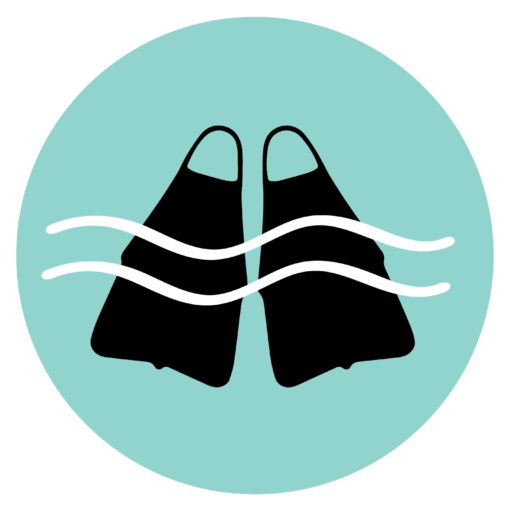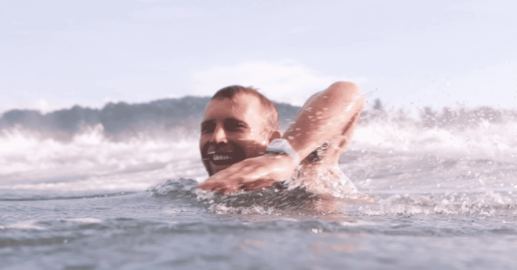I vividly remember the day I fell in love with bodysurfing.
I was on vacation in Hawaii and the weather was perfect—hot, sunny, dry, clear skies. Having recently graduated from the University of San Diego, I was completely relaxed and stress-free.
I was headed to hike a rugged stretch of coast when I noticed an empty wave along the way. I had my swim fins with me, so I decided to pull over and go for a quick frolick.
This wave was ideal for bodysurfing—steep, hollow, and fast—and it was all mine. I couldn’t believe my luck.
After thirty minutes of non-stop tube rides, I floated on my back for a while, taking in my surroundings.
Steep, verdant mountains stood tall in the background. The ocean water was crystal-clear and sparkling in the afternoon light—a beautiful shade of sun-dappled turquoise.
I closed my eyes and a sudden rush of gratitude came over me. At that moment, I felt as good as I’d ever felt. I was at home in my weightless body; completely present and open to life. I was safe in this aqueous arena of one.
As I lay there floating, I reflected upon my favorite Joseph Campbell quote.
In The Power of Myth, Campbell says, “If you follow your bliss, you put yourself on a kind of track that has been there all the while, waiting for you, and the life that you ought to be living is the one you are living. Wherever you are, if you are following your bliss, you are enjoying that refreshment, that life within you, all the time.”
I had found my bliss.

Years later, I heard legendary bodysurfer and longtime North Shore lifeguard Mark Cunningham describe a similar revelation he had about bodysurfing: “As a teenager, I remember very clearly sitting on the beach thinking this is as clean and beautiful and real and meaningful to me as anything in the world, and if it’s giving me pleasure and making me happy why shouldn’t I continue to do this as long as I can?”
Cunningham, now in his late 60s, is one of few icons in the sport of bodysurfing. He remains one of the best bodysurfers in the world today. Cunningham had followed bliss for most of his life and it worked out pretty well for him—why shouldn’t I?
On my flight back to Los Angeles, I couldn’t stop thinking about the transformative experience I had bodysurfing in Kauai. Was it possible to make a living as a bodysurfer?
Upon returning to California, I began devouring any information I could find about the sport of bodysurfing. The only problem was that there wasn’t much information to begin with.
Board-surfing has hundreds of books, magazines, films, and websites dedicated to the sport. A simple search of the term surfing turns up over a billion results on Google. Bodysurfing, on the other hand, turns up less than ten million.
Throughout the course of my research, I kept reading about a rare book titled The Art of Wave Riding. Written by Ron Drummond in 1931, this bodysurfing “how-to” manual had an initial print run of about 500 copies. It was the first published work on surfing of any kind, making it extremely valuable (and hard to find).
I tried buying the book off eBay, but the cheapest version I could find cost $5,000! Ultimately, I scheduled a reading of an original copy at UCLA’s special collections library.
From the moment I sat down to read The Art of Wave Riding, I knew I was in for a special treat. The opening line struck me: “A great deal of publicity has been given the Hawaiian swimmers on riding waves with surfboards. Without a doubt it is great sport, but in my estimation it cannot compare with the thrills, pleasure, and exercise of body surfing.”
Drummond continues:
One has only to watch a swarm of bathers at any crowded beach in order to see that thousands of people are interested in the sport. Whenever a good wave for riding comes in, about half the people make an attempt to ride it, and only about one-tenth of one per cent of them even get started on it. It is this pitiful sight of thousands of swimmers, young and old, men and women, always trying and never succeeding, that has urged me to put into print a few hints that I hope will be of some help in teaching the enthusiastic beach-goers the art of body surfing, and thus increase a thousand fold the pleasure derived from ocean bathing.
Drummond then presents a precise methodology for bodysurfing. I realized I could test Drummond’s methodology, so I drove to the nearest beach and tried it myself.
The most valuable thing I learned from Drummond was the importance of learning how to bodysurf white water waves without fins. Essentially, the bodysurfer must stand in waist-deep water and launch their body out in front of the oncoming broken wave, maintaining a streamline position as they ride to the beach.
I discovered that I could easily teach this technique to other people, and that’s when my true journey began.
Fast forward to today, I now live in Costa Rica where I make a living teaching people how to surf and bodysurf. I guess you could say I’ve spent nearly a decade following my bliss.
What I’ve come to believe is that bodysurfing is an essential skill for anyone spending time in the ocean—whether fisherman or surfer, boogie boarder or sailor—but most people neglect this simple fact. Have you ever heard of a bodysurf school, camp, or retreat?
Bodysurfing is not something that is widely taught—but it should be! Not only is bodysurfing easier and more accessible than board-surfing, it doesn’t have the same legacy of bigotry.
Unfortunately, most modern wave-riders tend to stick to their own faction. But being a true surfer is not about identifying with one particular sect of wave-riding. As Mark Cunningham would say, it’s about being in the ocean and having fun.
It just so happens that bodysurfing is the simplest and easiest way to have fun in the ocean. Even someone who is afraid of the ocean can learn to bodysurf in the white water.
My mission is to share all I’ve learned about bodysurfing since that blissful day in Kauai. I hope you find the information useful.


